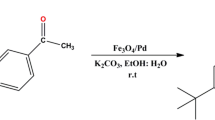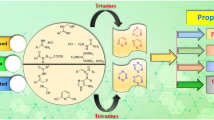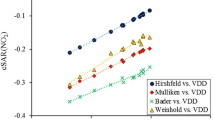Abstract
Adaptive aromaticity in the lowest singlet and triplet states is a rare property found among molecular systems. So far, only osmapentalene and osmapyridinium have been found to possess the adaptive aromaticity. Although it has been confirmed that the pattern of electron excitation is a key factor to achieve the adaptive aromaticity, further investigation of the metal center effect has not yet been made. Ruthenium, another Group 8 transition metal, can form metallacycles similar to the osmium counterparts. Here, we perform density functional theory calculations for two sets of ruthenacycles and analyze their aromaticity with multiple indices, revealing a 16-valence-electron ruthenapentalene being aromatic in both the singlet ground state (S0) and the lowest triplet state (T1) and extending the adaptive aromaticity to the second-row transition metal complexes.






Similar content being viewed by others
References
Faraday M (1825) On new compounds of carbon and hydrogen, and on certain other products obtained during the decomposition of oil by heat. Phil Trans R Soc Lond 115:440–466
Schleyer PvR, Jiao H (2009) What is aromaticity? Pure Appl Chem 68:209–218
Hückel E (1931) Quantentheoretische Beiträge zum Benzolproblem. Z Phys 70:204–286
Schleyer PvR (2001) Introduction: aromaticity. Chem Rev 101:1115–1118
Mitchell RH (2001) Measuring aromaticity by NMR. Chem Rev 101:1301–1316
Bleeke JR (2001) Metallabenzenes. Chem Rev 101:1205–1228
Bühl M, Hirsch A (2001) Spherical aromaticity of fullerenes. Chem Rev 101:1153–1184
De Proft F, Geerlings P (2001) Conceptual and computational DFT in the study of aromaticity. Chem Rev 101:1451–1464
Gomes JANF, Mallion RB (2001) Aromaticity and ring currents. Chem Rev 101:1349–1384
Krygowski TM, Cyrański MK (2001) Structural aspects of aromaticity. Chem Rev 101:1385–1420
Watson MD, Fechtenkötter A, Müllen K (2001) Big is beautiful − “aromaticity” revisited from the viewpoint of macromolecular and supramolecular benzene chemistry. Chem Rev 101:1267–1300
Williams RV (2001) Homoaromaticity. Chem Rev 101:1185–1204
Feixas F, Matito E, Poater J, Solà M (2015) Quantifying aromaticity with electron delocalisation measures. Chem Soc Rev 44:6434–6451
Ottosson H (2012) Organic photochemistry: exciting excited-state aromaticity. Nat Chem 4:969–971
Zimmerman HE (1966) On molecular orbital correlation diagrams, the occurrence of möbius systems in cyclization reactions, and factors controlling ground- and excited-state reactions. I. J Am Chem Soc 88:1564–1565
Dewar MJS (1966) A molecular orbital theory of organic chemistry—VIII. Tetrahedron 22:75–92
Rosenberg M, Dahlstrand C, Kilså K, Ottosson H (2014) Excited state aromaticity and antiaromaticity: opportunities for photophysical and photochemical rationalizations. Chem Rev 114:5379–5425
Oh J, Sung YM, Hong Y, Kim D (2018) Spectroscopic diagnosis of excited-state aromaticity: capturing electronic structures and conformations upon aromaticity reversal. Acc Chem Res 51:1349–1358
Baird NC (1972) Quantum organic photochemistry. II. Resonance and aromaticity in the lowest 3ππ* state of cyclic hydrocarbons. J Am Chem Soc 94:4941–4948
Heilbronner E (1964) Hűckel molecular orbitals of Mőbius-type conformations of annulenes. Tetrahedron Lett 5:1923–1928
Aihara J-I (1978) Aromaticity-based theory of pericyclic reactions. Bull Chem Soc Jpn 51:1788–1792
Karadakov PB (2008) Ground- and excited-state aromaticity and antiaromaticity in benzene and cyclobutadiene. J Phys Chem A 112:7303–7309
Feixas F, Vandenbussche J, Bultinck P, Matito E, Solà M (2011) Electron delocalization and aromaticity in low-lying excited states of archetypal organic compounds. Phys Chem Chem Phys 13:20690–20703
Chen D, Xie Q, Zhu J (2019) Unconventional aromaticity in organometallics: the power of transition metals. Acc Chem Res 52:1449–1460
Grande-Aztatzi R, Mercero JM, Matito E, Frenking G, Ugalde JM (2017) The aromaticity of dicupra[10]annulenes. Phys Chem Chem Phys 19:9669–9675
Szczepanik D, Solà M (2019) Electron delocalization in planar metallacycles: Hückel or Möbius aromatic? ChemistryOpen 8:219–227
Chen D, Shen T, An K, Zhu J (2018) Adaptive aromaticity in S 0 and T 1 states of pentalene incorporating 16 valence electron osmium. Commun Chem 1:18
Shen T, Chen D, Lin L, Zhu J (2019) Dual aromaticity in both the T 0 and S 1 states: osmapyridinium with phosphonium substituents. J Am Chem Soc 141:5720–5727
Craig DP, Paddock NL (1958) A novel type of aromaticity. Nature 181:1052–1053
Mauksch M, Tsogoeva SB (2016) Reversal of orbital symmetry control in electrocyclic ring closures through craig-möbius aromaticity. ChemPhysChem 17:963–966
Zhu C, Li S, Luo M, Zhou X, Niu Y, Lin M, Zhu J, Cao Z, Lu X, Wen T, Xie Z, Schleyer PvR, Xia H (2013) Stabilization of anti-aromatic and strained five-membered rings with a transition metal. Nat Chem 5:698–703
Zhu C, Luo M, Zhu Q, Zhu J, Schleyer PvR, Wu JI-C, Lu X, Xia H (2014) Planar Möbius aromatic pentalenes incorporating 16 and 18 valence electron osmiums. Nat Commun 5:3265
Liu B, Wang H, Xie H, Zeng B, Chen J, Tao J, Wen TB, Cao Z, Xia H (2009) Osmapyridine and osmapyridinium from a formal [4 + 2] cycloaddition reaction. Angew Chem Int Ed 48:5430–5434
Solà M (2017) Why aromaticity is a suspicious concept? Why? Front Chem 5:22
Frisch MJ, Trucks GW, Schlegel HB, Scuseria GE, Robb MA, Cheeseman JR, Scalmani G, Barone V, Petersson GA, Nakatsuji H, Li X, Caricato M, Marenich A, Bloino J, Janesko BG, Gomperts R, Mennucci B, Hratchian HP, Ortiz JV, Izmaylov AF, Sonnenberg JL, Williams-Young D, Ding F, Lipparini F, Egidi F, Goings J, Peng B, Petrone A, Henderson T, Ranasinghe D, Zakrzewski VG, Gao J, Rega N, Zheng G, Liang W, Hada M, Ehara M, Toyota K, Fukuda R, Hasegawa J, Ishida M, Nakajima T, Honda Y, Kitao O, Nakai H, Vreven T, Throssell K, Montgomery JA Jr, Peralta JE, Ogliaro F, Bearpark M, Heyd JJ, Brothers E, Kudin KN, Staroverov VN, Keith T, Kobayashi R, Normand J, Raghavachari K, Rendell A, Burant JC, Iyengar SS, Tomasi J, Cossi M, Millam JM, Klene M, Adamo C, Cammi R, Ochterski JW, Martin RL, Morokuma K, Farkas O, Foresman JB, Fox DJ (2016) Gaussian 09. Revision E.01, Gaussian. Inc., Wallingford CT
Schleyer PvR, Maerker C, Dransfeld A, Jiao H, Hommes NJRVE (1996) Nucleus-independent chemical shifts: a simple and efficient aromaticity probe. J Am Chem Soc 118:6317–6318
Chen Z, Wannere CS, Corminboeuf C, Puchta R, Schleyer PvR (2005) Nucleus-independent chemical shifts (NICS) as an aromaticity criterion. Chem Rev 105:3842–3888
Herges R, Geuenich D (2001) Delocalization of electrons in molecules. J Phys Chem A 105:3214–3220
Geuenich D, Hess K, Köhler F, Herges R (2005) Anisotropy of the induced current density (ACID), a general method to quantify and visualize electronic delocalization. Chem Rev 105:3758–3772
Friedrich K, Seifert G, Großmann G (1990) Nuclear magnetic shielding in molecules. The application of GIAO’s in LCAO-Xα-calculations. Z Phys D Atom Mol Cl 17:45–46
Keith TA, Bader RFW (1993) Topological analysis of magnetically induced molecular current distributions. J Chem Phys 99:3669–3682
Swart M (2008) Accurate spin-state energies for iron complexes. J Chem Theor Comput 4:2057–2066
Swart M, Gruden M (2016) Spinning around in transition-metal chemistry. Acc Chem Res 49:2690–2697
Szczepanik DW, Andrzejak M, Dyduch K, Zak E, Makowski M, Mazur G, Mrozek J (2014) A uniform approach to the description of multicenter bonding. Phys Chem Chem Phys 16:20514–20523
Szczepanik DW RunEDDB script. http://www.eddb.pl. Accessed Sept 2019
Glendening ED, Landis CR, Weinhold F (2013) NBO 6.0: natural bond orbital analysis program. J Comput Chem 34:1429–1437
Fallah-Bagher-Shaidaei H, Wannere CS, Corminboeuf C, Puchta R, Schleyer PvR (2006) Which NICS aromaticity index for planar π rings is best? Org Lett 8:863–866
Stanger A (2006) Nucleus-independent chemical shifts (NICS): distance dependence and revised criteria for aromaticity and antiaromaticity. J Org Chem 71:883–893
Krygowski TM (1993) Crystallographic studies of inter- and intramolecular interactions reflected in aromatic character of π-electron systems. J Chem Inf Comput Sci 33:70–78
Foroutan-Nejad C (2015) Is NICS a reliable aromaticity index for transition metal clusters? Theor Chem Acc 134:8
Shaik SS, Hiberty PC (1985) When does electronic delocalization become a driving force of molecular shape and stability? 1. The aromatic sextet. J Am Chem Soc 107:3089–3095
Hiberty PC, Shaik SS, Ohanessian G, Lefour JM (1986) The π-distortive propensities in benzene and the allyl radical. A reply to a criticism. J Org Chem 51:3908–3909
Acknowledgements
Financial support by the National Science Foundation of China (21873079 and 21573179) and the Top-Notch Young Talents Program of China is gratefully acknowledged.
Author information
Authors and Affiliations
Corresponding author
Additional information
Publisher's Note
Springer Nature remains neutral with regard to jurisdictional claims in published maps and institutional affiliations.
Published as part of the special collection of articles derived from the Chemical Concepts from Theory and Computation.
Electronic supplementary material
Below is the link to the electronic supplementary material.
Rights and permissions
About this article
Cite this article
Chen, D., Qiu, R., Dong, S. et al. Adaptive aromaticity in ruthenacycles. Theor Chem Acc 139, 21 (2020). https://doi.org/10.1007/s00214-019-2537-8
Received:
Accepted:
Published:
DOI: https://doi.org/10.1007/s00214-019-2537-8




